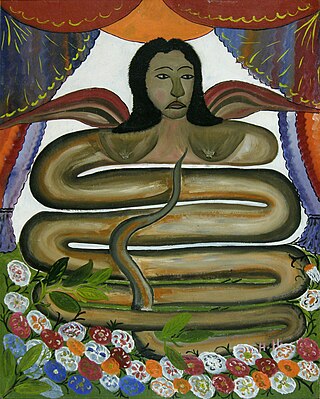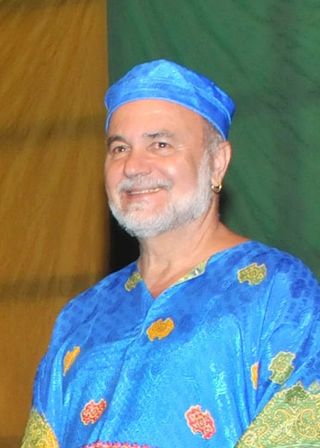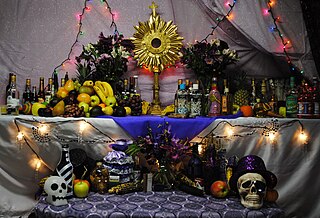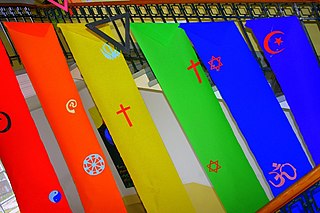
Lwa, also called loa or loi, are spirits in the African diasporic religion of Haitian Vodou. They have also been incorporated into some revivalist forms of Louisiana Voodoo. Many of the lwa derive their identities in part from deities venerated in the traditional religions of West Africa, especially those of the Fon and Yoruba.

Baron Samedi, also written Baron Samdi, Bawon Samedi or Bawon Sanmdi, is one of the lwa of Haitian Vodou. He is a lwa of the dead, along with Baron's numerous other incarnations Baron Cimetière, Baron La Croix and Baron Criminel.
The Gede are the family of lwa that represent the powers of death and fertility. Gede spirits include Gede Doub, Guede-Linto, Guede L'Orage, Guede Nibo and Guede Ti Malice. All are known for the drum rhythm and dance called the "banda". In possession, they will drink or rub themselves with a mixture of clairin and twenty-one scotch bonnet or goat peppers. Fèt Gede is celebrated on 2 November, All Souls' Day. Boons granted by the Gede not repaid by this date will be avenged afterwards.

Maman Brigitte sometimes also written as Manman Brigitte and also known by Gran Brigitte, Grann Brigitte, Manman, Manman Brigit, and Maman Brijit is a death loa and the consort of Baron Samedi in Haitian Vodou. She drinks rum infused with hot peppers and is symbolized by a black rooster. Maman Brigitte protects graves in Haitian cemeteries that are marked by the cross of Baron Samedi. Graves that are protected by Brigitte are marked by a mound of stones. In Vodou practice, the first burials serve as offerings to either Baron Samedi or Maman Brigitte depending on the gender of the person being laid to rest. If the deceased person is male then the grave is dedicated to Baron Samedi; if the deceased person is female then the grave is dedicated to Maman Brigitte.
LGBT slang, LGBT speak, queer slang or gay slang is a set of English slang lexicon used predominantly among LGBTQ+ people. It has been used in various languages since the early 20th century as a means by which members of the LGBTQ+ community identify themselves and speak in code with brevity and speed to others. The acronym LGBT was popularized in the 1990s and stands for Lesbian, Gay, Bisexual, and Transgender. It may refer to anyone who is non-heterosexual or non-cisgender, instead of exclusively to people who are lesbian, gay, bisexual, or transgender. To recognize this inclusion, a popular variant, LGBTQ, adds the letter Q for those who identify as queer or are questioning their sexual or gender identity.

Non-heterosexual is a word for a sexual orientation or sexual identity that is not heterosexual. The term helps define the "concept of what is the norm and how a particular group is different from that norm". Non-heterosexual is used in feminist and gender studies fields as well as general academic literature to help differentiate between sexual identities chosen, prescribed and simply assumed, with varying understanding of implications of those sexual identities. The term is similar to queer, though less politically charged and more clinical; queer generally refers to being non-normative and non-heterosexual. Some view the term as being contentious and pejorative as it "labels people against the perceived norm of heterosexuality, thus reinforcing heteronormativity". Still, others say non-heterosexual is the only term useful to maintaining coherence in research and suggest it "highlights a shortcoming in our language around sexual identity"; for instance, its use can enable bisexual erasure.

Luiz Roberto de Barros Mott or Luiz Mott in São Paulo, is an anthropologist and a gay rights activist in Brazil.
Takatāpui is a Māori language term that is used in a similar way to LGBT. When speaking Māori, LGBT people of any culture are referred to as takatāpui. In English, a takatāpui person is a Māori individual who is gay, lesbian, bisexual, or transgender (LGBT).

Homosexuality in Haitian Vodou is religiously acceptable and homosexuals are allowed to participate in all religious activities. However, in West African countries with major conservative Christian and Islamic views on LGBTQ people, the attitudes towards them may be less tolerant if not openly hostile and these influences are reflected in African diaspora religions following Atlantic slave trade which includes Haitian Vodou.
The bisexual community, also known as the bi+, m-spec, bisexual/pansexual, or bi/pan/fluid community, includes members of the LGBT community who identify as bisexual, pansexual, omnisexual, polysexual and sexually fluid. As opposed to hetero- or homosexual people, people in the bisexual community experience attraction to more than one gender.
Gede Nibo is a lwa who is leader of the spirits of the dead in Haitian Vodou. Formerly human, Gede Nibo was a handsome young man who was killed violently. After death, he was adopted as a lwa by Baron Samedi and Maman Brigitte. He is envisioned as an effeminate, nasal dandy. Nibo wears a black riding coat or drag. When he inhabits humans they are inspired to lascivious sexuality of all kinds.

LGBT themes in mythology occur in mythologies and religious narratives that include stories of romantic affection or sexuality between figures of the same sex or that feature divine actions that result in changes in gender. These myths are considered by some modern queer scholars to be forms of lesbian, gay, bisexual, or transgender (LGBT) expression, and modern conceptions of sexuality and gender have been retroactively applied to them. Many mythologies ascribe homosexuality and gender fluidity in humans to the action of gods or of other supernatural interventions.
Greco-Roman mythology features male homosexuality in many of the constituent myths. In addition, there are instances of cross-dressing, and of androgyny which has been grouped under the acronym LGBTQ+.
Chinese mythology has been described as "rich in stories about homosexuality", reflecting ancient Chinese perspectives toward variance in sexuality and gender, rather than modern views. Chinese myths and traditional folk tales are greatly influenced by religious beliefs, particularly Taoist, Confucian, and Buddhist teachings.

The relationship between religion and lesbian, gay, bisexual, and transgender (LGBT) people can vary greatly across time and place, within and between different religions and sects, and regarding different forms of homosexuality, bisexuality, non-binary, and transgender identities. More generally, the relationship between religion and sexuality ranges widely among and within them, from giving sex and sexuality a rather negative connotation to believing that sex is the highest expression of the divine.

In Hindu Epic, there are deities or heroes whose attributes or behavior can be interpreted as lesbian, gay, bisexual, or transgender (LGBT) or have elements of gender variance and non-heterosexual sexuality. Traditional Hindu literary sources do not speak of homosexuality directly, but changes of sex, homoerotic encounters, and intersex or third gender characters are often found both in traditional religious narratives such as the Vedas, Mahabharata, Ramayana and Puranas as well as in regional folklore.

The lesbian, gay, bisexual and transgender (LGBT) community in San Francisco is one of the largest and most prominent LGBT communities in the United States, and is one of the most important in the history of American LGBT rights and activism alongside New York City. The city itself has been described as "the original 'gay-friendly city'". LGBT culture is also active within companies that are based in Silicon Valley, which is located within the southern San Francisco Bay Area.

The following outline offers an overview and guide to LGBT topics.
A mudoko dako is an effeminate male who is considered by Langi society to be a different gender, though were mostly treated as woman among the Langi in Uganda. Mudoko dako also could be found among the Teso and the Karamojan people. Recognition of the mudoko dako can be traced back prior to colonialism in Africa.











